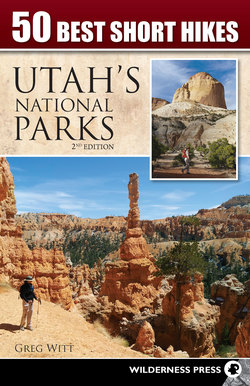Читать книгу 50 Best Short Hikes in Utah's National Parks - Greg Witt - Страница 23
На сайте Литреса книга снята с продажи.
Оглавление4 Double Arch
Trailhead Location: In the Windows section, on the north side of the Double Arch parking area
Trail Use: Walking, hiking
Distance & Configuration: 0.6-mile out-and-back
Elevation Range: 5,132' at trailhead to 5,210' within the arch
Facilities: Vault toilet near trailhead
Highlights: An easy, short walk to the second-largest arch in the park, which is also one of the most intriguing
DESCRIPTION
Double Arch is a spectacular sight and one of the most popular arches in the park. Because of its fame, if you want to have it to yourself, consider making this an early-morning or late-afternoon stop. Even if this is your first visit to Arches, you may remember seeing this arch before in the opening scene of Indiana Jones and the Last Crusade. But don’t bother looking for the treasure-laden cave nearby—that was pure Hollywood.
Double Arch
The eastern arch (the one closest to the trailhead) is 104 feet high and 148 feet wide, as measured with high-tech laser equipment in 2009, while the smaller, more circular western arch is 60 feet by 60 feet. No guardrails or fences keep you from exploring underneath and around the arches, so enjoy them to your heart’s content.
ROUTE
From the well-marked trailhead, the route descends slightly and heads directly toward the arch, with only a small amount of undulation and weaving. You must contend with some sand, but the trail is an easy jaunt suitable for all hikers. Along this flat you’ll see junipers and oaks, with wildflowers in the spring, including Utah’s state flower, the sego lily, with its large, three-petaled white flower. Indigenous peoples roasted sego lily bulbs or cooked them in stews. Later, Mormon pioneers ate the bulbs during their first years in Utah, especially in times of drought or crop failure.
To the left side of the trail you’ll see a formation called the Parade of Elephants. Most people will comment on the elephant-shaped rocks before even knowing the name—it’s that obvious.
When you arrive at Double Arch and enter into the chamber of the two arches, you might feel as though you’re inside one of those mind-bending, impossible M. C. Escher etchings. Look up and around—are there two arches or three? If you count the top opening as an arch, you could call this Triple Arch, but actually, the top opening is not an arch, though it is instrumental in the forming of Double Arch.
Double Arch is defined as a pothole arch because it was formed by water erosion from above, so the arch overhead is where the water settled that then seeped down and began the formation of the arch, first by creating large alcoves and then by breaking through to complete the full arch. Most other arches form from the side.
Once you’ve wrapped your mind around this geologic puzzle, you can make your way back to the parking lot the way you came.
TO THE TRAILHEAD
GPS Coordinates: N38º 41.299' W109º 32.301'
From the Arches National Park entrance station, continue on Arches Scenic Drive (the main park road) for 8.9 miles to the road signed for the Windows section. Turn right and follow The Windows Road for 2.6 miles to the loop parking area at the end of the road. The Double Arch Trailhead is on the north side of the parking area.
WHERE ARE THE LEAVES ON THE MORMON TEA SHRUB?
While inspecting the Mormon tea shrub, also known as ephedra, you may see a lot of naked, jointed, green branches. Look closely at the joints; you’ll find tiny scalelike leaves. If you’re observing the plant between February and April, you may even find small flowers blooming. Mormon tea, a mild stimulant and diuretic, was prized for its medicinal properties by both ancient inhabitants and early settlers. (Note: This species of ephedra is different from the kind that was banned by the Food and Drug Administration as an ingredient in over-the-counter health supplements.)
